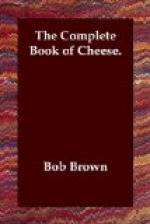Champagne will not a dinner
make,
Nor caviar a meal
Men gluttonous and rich may
take
Those till they
make them ill
If
I’ve potatoes to my chop,
And
after chop have cheese,
Angels
in Pond and Spiers’s shop
Know
no such luxuries.
All that’s necessary is an old-time “cheese stewer” or a reasonable substitute. The base of this is what was once quaintly called a “hot-water bath.” This was a sort of miniature wash boiler just big enough to fit in snugly half a dozen individual tins, made squarish and standing high enough above the bath water to keep any of it from getting into the stew. In these tins the cheese is melted. But since such a tinsmith’s contraption is hard to come by in these days of fireproof cooking glass, we suggest muffin tins, ramekins or even small cups to crowd into the bottom of your double boiler or chafing dish. But beyond this we plump for a revival of the “cheese stewer” in stainless steel, silver or glass.
In the ritual at “The Cheese,” these dishes, brimming over, “bubbling and blistering with the stew,” followed a pudding that’s still famous. Although down the centuries the recipe has been kept secret, the identifiable ingredients have been itemized as follows: “Tender steak, savory oyster, seductive kidney, fascinating lark, rich gravy, ardent pepper and delicate paste”—not to mention mushrooms. And after the second or third helping of pudding, with a pint of stout, bitter, or the mildest and mellowest brown October Ale in a dented pewter pot, “the stewed Cheshire cheese.”
Cheese was the one and only other course prescribed by tradition and appetite from the time when Charles II aled and regaled Nell Gwyn at “The Cheese,” where Shakespeare is said to have sampled this “kind of a glorified Welsh Rarebit, served piping hot in the square shallow tins in which it is cooked and garnished with sippets of delicately colored toast.”
Among early records is this report of Addison’s in The Spectator of September 25,1711:
They yawn for a Cheshire cheese, and begin about midnight, when the whole company is disposed to be drowsy. He that yawns widest, and at the same time so naturally as to produce the most yawns amongst his spectators, carries home the cheese.
Only a short time later, in 1725, the proprietor of Simpson’s in the Strand inaugurated a daily guessing contest that drew crowds to his fashionable eating and drinking place. He would set forth a huge portion of cheese and wager champagne and cigars for the house that no one present could correctly estimate the weight, height and girth of it.
As late as 1795, when Boswell was accompanying Dr. Johnson to “The Cheese,” records of St. Dunstan’s Club, which also met there, showed that the current price of a Buck Rabbit was tuppence, and that this was also the amount of the usual tip.




